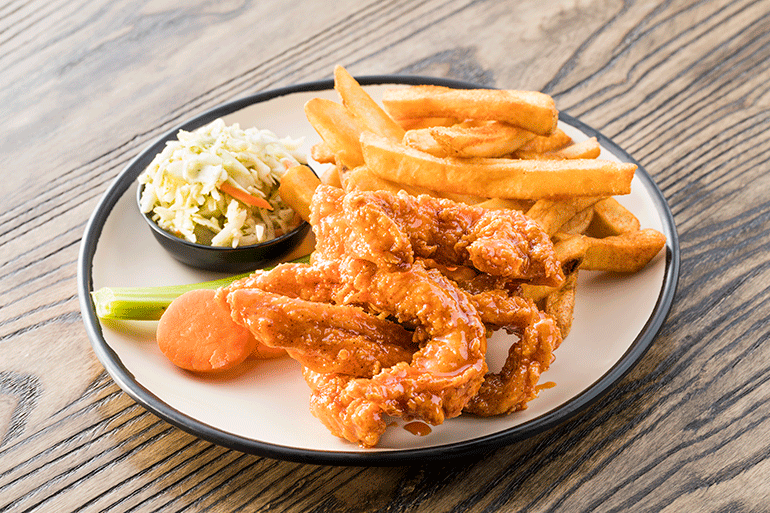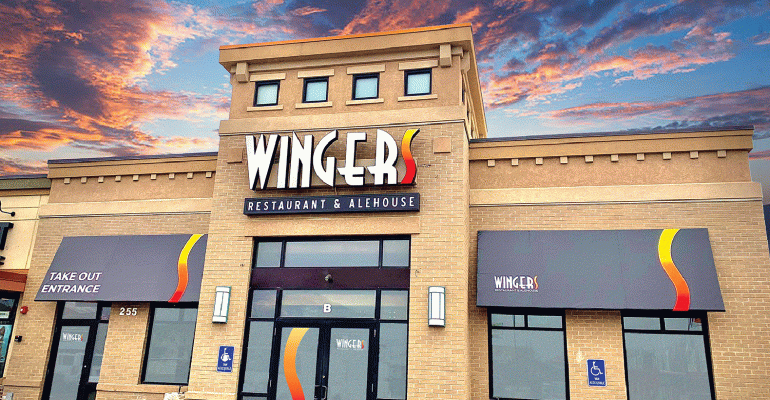Increasing consumer demand and pressures in the supply chain are driving up the costs of chicken wings by as much as 50%, and some restaurant operators are reporting challenges in obtaining enough supply.
Contributing to the wing shortages and price increases have been the proliferation of new delivery-only wing concepts, such as It’s Just Wings from Brinker International, which is on track to become a $150 million brand in its first year, the company said in a conference call with analysts on Wednesday.
While large, established wing specialists say their strong relationships with suppliers will help them weather the situation, many smaller and regional operators have been struggling to stay in-stock.
Brandon Howard, chief operating officer at Salt Lake City-based Wingers, said the company has turned to alternate suppliers and has begun promoting other items on its menu as it has not been able to source enough wings to meet its typical demand.
“We usually average 1,500-1,800 cases a week, and we started seeing 500 cases delivered,” he told Nation’s Restaurant News. “As you can imagine, a 1,300-case shortage is a big concern.”
Wingers, which has 23 units, had ordered an additional 2,500 cases before the Super Bowl, which is the single biggest day of the year for wing consumption, but that surplus ran out earlier than expected, Howard said. The company has since been sourcing as much as possible from Costco Wholesale, which he said offers a product that is similar in its specifications to what Wingers normally buys. Costco, however, has since implemented a two-case limit, leaving Wingers without a viable supply alternative.
Fortunately, Howard said, the chain had already been focusing on diversifying its menu for the last several years and has been steering customers toward different products, including its new Tennessee Hot Legs, which are chicken drumsticks that offer the same flavor profiles as its wings. It is also showcasing its signature Sticky Fingers, which are breaded strips of breast meat, and a new item it has tested periodically called Pig Wings, which are breaded, deep-fried pork riblets.
In addition, Wingers is taking wing platters off of its menu and is limiting bone-in wings to seven-and-10 piece appetizers and entrées, and is seeking to steer customers towards combo entrées that pair wings or Sticky Fingers with other items.
The company has partnered with Tyson for its supply of drumsticks for the Tennessee Hot Legs, which Howard said will be a centerpiece of the chain’s new menu that is scheduled to debut in the coming weeks. The item, which will carry the same price point as its wing dishes and will be prepared using the same batter and sauces, tested well during the past year at one of the chain’s locations, Howard said.
“For the traditional wing eater that’s looking for that bone-in, handheld product, it's all about the sauces and our signature batter,” he said. “I think they're the driver.”
In order to support the shift in its menu focus, Wingers has invested in training its staff about how to communicate about the wing supply shortage, and has also communicated the situation via in-store signage and online messaging.
“For the most part, people are very patient,” said Howard. “We explain to them that there's a national wing shortage, and that as a result of that, we are limiting the amount of wings that we can sell.”
Although its costs for wings have increased, Wingers has not raised menu prices, he said. This aligns with its strategy of absorbing fluctuating cost increases for other ingredients, such as avocados.

Wingers is steering customers to other items such as its Sticky Fingers.
Howard said that based on information from suppliers, the chicken wing shortage could last until late August or early September.
Meanwhile, the company reported this week that its same-store sales were up 9% in the March 1-28 time frame, compared with Feb. 1-28, and that 40% of its locations achieved record sales during the week of March 15, as in-store dining returns to the chain.
“Through proper training and being creative with our menu items, we’re actually doing quite well in overcoming the challenges right now,” Howard said.
Meanwhile Dallas-based Wingstop, in a conference call with analysts on Wednesday discussing its first-quarter financial results, said the cost of bone-in wings on the spot market increased more than 50% year-over-year. The company’s pricing strategies and relationships with suppliers helped the company hold its own increase to 25.8%, however, compared to the first quarter of a year ago, said Michael Skipworth, CFO.
He attributed much of the supply shortage to the government stimulus, which he said has presented challenges for suppliers to find adequate staffing.
“Until we see a marked change in the availability of labor for poultry producers … we anticipate that wing prices could remain elevated for the balance of 2021,” Skipworth said.
In a statement provided to Nation’s Restaurant News, distributor U.S. Foods agreed that labor shortages have contributed to the problem.
“Meat processors are having a hard time keeping up with increased demand due to a variety of challenges, such a labor,” the company said. “We’re staying closely connected with our suppliers to manage needs and we’re committed to working with our customers to help them navigate through the supplier constraints.”
Ron Ruggless contributed to this story.





